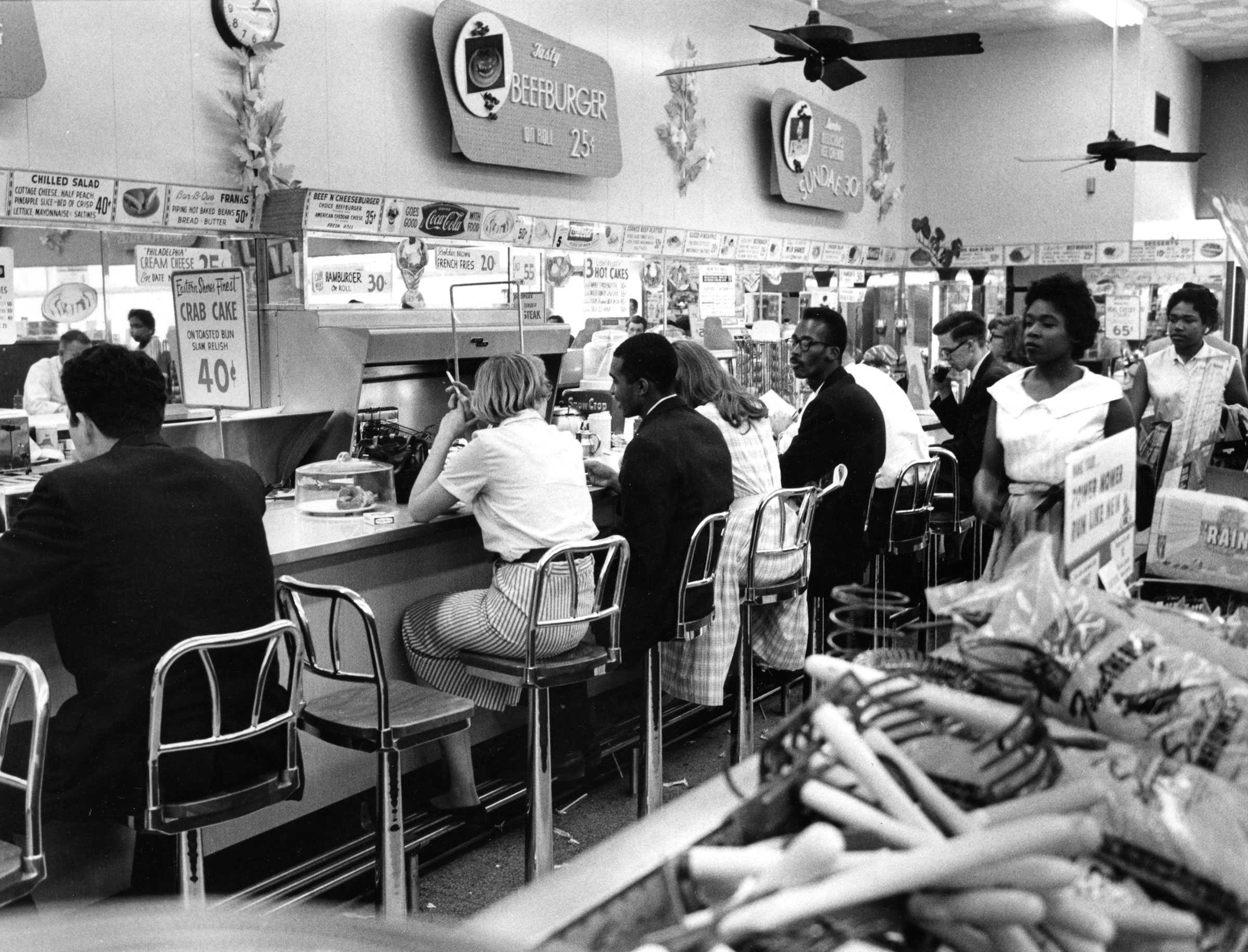Chapter 3
Protesting and Marching for Civil Rights
African Americans resisted segregation through individual and collective action. Privately, they attended to their families, their communities, and their lives. Publicly, they boycotted, marched, and protested, forcing businesses and cities to desegregate.
Organizations such as the Southern Christian Leadership Conference (SCLC) and the Student Nonviolent Coordinating Committee (SNCC) provided training and funding for desegregation efforts.
The Sit-In Movement
Sit-in participants believed that nonviolence was a stark contrast to segregationist violence. Sit-in participants were trained to sit quietly without responding to aggression, and if attacked, to curl into a ball and take the punishment. If they were arrested, others would take their place.
Sit-Ins at Dockum Drug Store
Kansas
Student sit-in at Dockum Drug Store, Wichita, Kansas, 1958
In 1958, ten African American students entered the Dockum Drug Store in Wichita, Kansas, and sat at the lunch counter, waiting to be served. They arrived well-dressed and only spoke when addressed by the Dockum staff.
White students also joined them, and similar protests were launched at other Dockum stores in Wichita. Revenue at the drugstores began to decline, and 23 days after the movement began, store owners agreed to integrate their lunch counters.
Sit-In at the Greensboro Woolworth’s
North Carolina
Lunch counter stool from a Woolworth’s in Greensboro, North Carolina
In 1960, during their freshman year at North Carolina Agricultural & Technical University, Joseph McNeil, Franklin McCain, David Richmond, and Ezell Blair Jr. spent hours discussing racial issues. After their conversations, they decided to sit-in at the local Woolworth’s lunch counter.
The men contacted a reporter, bought items at Woolworth’s, and sat at the lunch counter requesting service. After being refused service they left the store but returned the next day with other students. Their protest spread to other stores across the city and across the state.
Though the demonstrators were spat upon, harassed, pelted with eggs, and arrested, lunch counters across North Carolina soon began desegregating. The protests’ success drew many Black and white students into the Civil Rights Movement.
High Point high school student's sit-in at Woolworth’s
I had the most wonderful feeling. I had a feeling of liberation, restored manhood. I had a natural high. And I truly felt almost invincible. Mind you, [I was] just sitting on a dumb stool and not having asked for service yet.
Franklin McCain, 2008
Nashville Sit-Ins
Tennessee
Sit-in at Walgreens, Nashville, Tennessee, 1960
In 1960, led by Diane Nash and John Lewis, students at colleges around Nashville, Tennessee, began sitting in at Kress, Woolworth, and McClellan stores. Despite attacks and police arrests, the sit-ins spread. When the students were threatened with expulsion from college and their attorney’s home was bombed, escalating violence persuaded Nashville’s mayor to support integration. Nashville became the first southern city to desegregate and served as an example of sit-ins’ power.
Nonviolent Action Group Sit-Ins
Virginia
The first day of sit-ins at Peoples Drug, Arlington, Virginia, 1960
In 1960 the interracial Nonviolent Action Group (NAG), founded by Howard University students in Washington, D.C., began sit-ins at Peoples Drug, Drug Fair, Lansburgh’s, Woolworth’s, and Howard Johnson’s Restaurant in Arlington, Virginia. The manager at Peoples Drug even removed seats to prevent demonstrations. But after several weeks, businesses relented and integrated their stores. Students from NAG had later success at Glen Echo amusement park, the Hi-Boy restaurant, and the Hiser Theater in Maryland.
